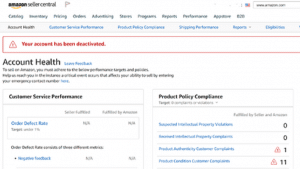
One of our clients was selling face masks on Amazon that she had purchased on Alibaba. Another was selling pretzels he had bought from Hobby Lobby. A third was selling Microsoft products (allegedly) that he had bought from a third-party site. All three did not realize that they were violating Amazon’s policies in doing so. And despite that lack of knowledge (or perhaps because of it), all three had their Amazon Seller Central accounts suspended due to counterfeit concerns.
Amazon HATES counterfeits! And while there are black hat sellers on Amazon who are knowingly selling counterfeit products, Amazon doesn’t just direct its counterfeit ire toward those bad sellers. As with most policy enforcement, Amazon goes broad, trying to protect its customers and remove any potentially counterfeit products from its site proactively.

Indeed, Amazon launched an effort three years ago called Project Zero. The stated goal of Project Zero is to drive counterfeits on Amazon to … you guessed it – zero. It does that by using a mixture of “automated processes” (read: heartless robots) and unquestioned self-reporting from brand owners. As you might expect, this catches innocent sellers alongside uninformed ones alongside malicious ones. And in the court of Amazon, all are guilty until proven innocent. But we’re here to help!
If you’re worried about counterfeit claims, or are already the recipient of some, or are simply curious because you’ve heard the horror stories, here are 6 quick tips for navigating counterfeit issues on Amazon.
- Know Amazon’s anti-counterfeiting policy
Remember: Amazon HATES counterfeits. We hear from Amazon sellers all the time who say: “But I’ve been selling these products on Ebay for years and never had an issue!” Welcome to Amazon! Amazon’s Anti-Counterfeiting policy is strict, and like most Amazon policies, it assumes guilt. While we encourage you to read it in full, here are the highlights:
- You, the seller, are responsible for ensuring all products you sell are authentic.
- Prohibited products aren’t just the obvious ones like bootlegs and fakes, but also ones that you might not even realize are protected intellectual property. As our client learned, you can’t just sell Microsoft products without Microsoft’s permission.
- You may be asked to provide proof of authenticity at any time, and failure to do so leads to an assumption that your products are counterfeit.
- Selling products that you cannot prove are authentic may lead Amazon to immediately suspend your seller central account, dispose of any Fulfillment by Amazon (FBA) inventory you have, withhold your funds, and even pursue civil and criminal penalties.
As you can see, Amazon takes this very seriously, so we encourage you to connect with us – Amazon Seller Central experts – if you have any questions or concerns about it.
- If you get a complaint, respond immediately
Because Amazon is trying (or has been trying for three years) to drive counterfeits to zero, it does not give you many chances or wait patiently if you get a counterfeit complaint (which can include intellectual property or authenticity complaints). As soon as you receive such a complaint in your Amazon Seller Central account, make sure you act promptly.

You may even be able to act (and you should!) before you get a complaint. If, for example, you get customer messages or reviews saying that your product was not what they expected, act fast to figure out what is going on. It’s possible that you simply need to update your product picture or description, or that you need better packaging, or that the customer simply had mistaken expectations. But failing to meet those expectations is often one step away from a counterfeit complaint, and a counterfeit complaint is often one step away (or less) from an account suspension.
In fact, if you take action before you receive a violation, and you do eventually receive a violation, you can include that in your Plan of Action and impress Amazon with your proactiveness. For example: “I noticed NCX feedback in which customers questioned the product’s authenticity because it was shipped in generic packaging. I have already contacted my supplier to address this, and my next FBA shipment will have the product wrapped in branded packaging.”
If you’re not sure how to handle complaints, or even where to find them or how to anticipate them, don’t hesitate to reach out. We’d be happy to help you with Account Monitoring or responding to the complaints themselves.
- Call Amazon to learn more
While it’s important to act fast, it’s also important to act smart. If you received a complaint and you’re not sure why – or if your ASIN or account has already been suspended for counterfeit reasons – if helps to learn more before responding. A good first step is to connect with Amazon to get more details about the triggering complaint. For example, you might ask for the name and email of the rights owner if you received a copyright violation.
That said, getting a hold of a helpful Amazon agent – or even getting a hold of any agent at all – can be a challenge. We spend every day on the phone with Amazon on behalf of our clients, so let us know if we can help you connect with Amazon to get answers about your account.

- Get authentication documents
The best way to prove that your products are not counterfeit is to get authentication documents from the manufacturer or supplier. And the best time to do that is right now. Whether you have already been suspended, or you are just starting to sell, make sure you get legitimate business invoices that demonstrate that you have purchased your products from an authorized supplier. And if, for example, you are selling Microsoft products like our client was, make sure that supplier is indeed authorized by visiting Microsoft’s site and finding their list of approved distributors.
An important note is that retail receipts do not count as legitimate invoices to Amazon. So even if you went to Hobby Lobby yourself and purchased the pretzels that you know are authentic from the store, your receipt will not serve as proof of that to Amazon if your products are flagged as counterfeits. In that way, retail arbitrage is a risky business. We are happy to talk you through what constitutes a legitimate invoice and how to verify that a supplier is authorized if you need help with this step.
- Don’t alter or fake any documents!
One of the only things Amazon hates more than counterfeit products is counterfeit documents. If you are not able to get authentication documents from the rights owner, never, ever, ever fake them! You may think you’re a regular Frank Abagnale, but trust us when we say from years of experience that Amazon will catch you, and they will not be happy.

Faking documents may seem easier than changing your business model, but counterfeit documents leads to a suspension that is very hard to come back from (though we regularly achieve it – so let us know if this is you), while a new business plan can lead to a restored account and ongoing profits. Which would you prefer? If you can’t get legitimate documents from your supplier, it’s time to find a new supplier or cut that product from your store.
- Write a strong plan of action
Remember the title of this post? Amazon doesn’t frown on counterfeits. It hates counterfeits! So, if you have been suspended for counterfeits, it’s going to take hard work to get reinstated. The easiest path is to prove that the whole thing was just one big misunderstanding, but you can only do that if you have the documents to back it up. If you do not, then it’s time to change course. You must write a detailed plan of action that proves to Amazon that you understand the root cause of the issue, that you have taken immediate measures to fix it, and that you have made real and long-term changes to your operation to avoid ever having counterfeit claims again.
That’s what happened with our three clients above. All were selling very different products that they did not have the right to sell. All were suspended from Amazon’s marketplace for counterfeit concerns, their stores frozen and their assets held. And eventually, after working with us and making substantive changes to their methods, all were reinstated and able to get back to selling – and making a profit – on Amazon.
We specialize in helping clients navigate Amazon’s strict rules and sometimes random enforcement. So if you’re struggling to make sense of any of this, or to respond to Amazon or counterfeit complaints and suspensions, let us know how we can help. We love helping Amazon sellers get back online – and stay there.





